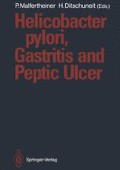Abstract
It is now accepted that Helicobacter pylori (H. pylori) causes type B gastritis. Apart from its putative role as a cofactor in ulcerogenesis, H. pylori infection seems to be a predictive factor for ulcer recurrence [1]. Although H. pylori is known to alter gastric and duodenal morphology and function, the pathogenetic mechanisms behind the observed disturbances are only partly elucidated.
Access this chapter
Tax calculation will be finalised at checkout
Purchases are for personal use only
Preview
Unable to display preview. Download preview PDF.
References
Borody T, Cole P, Noionan S, et al. (1988) Long-term Campylobacter pylori recurrence posteradication. Gastroenterology 94:43.
Hengels KJ, Heinrich G, Strohmeyer G (1986) Relationship between peptic cell mass, mucosal pepsinogen concentration, and pepsinogen secretion in normal gastric mucosa and gastritis. Gastroenterology 90:1457.
Samloff IM, Liebman WM (1974) Radioimmunoassay of group I pepsinogens in serum. Gastroenterology 66:494–502.
Samloff IM (1982) Pepsinogen I and II. Purification from gastric mucosa and radioimmunoassay in serum. Gsstroenterology 82:26–33.
Samloff IM, Varis K, Ihamäki T, et al. (1982) Relationship among serum pepsinogen I, and II, and gastric mucosal histology. Gastroenterology 83:204–209.
Samloff IM, Taggart RT, Hengels KJ (1985) Molecular variants of human aspartic proteinases. In: Kostka V (ed) Aspartic proteinases and their inhibitors. de Gruyter, Berlin, pp 79–85.
Samloff IM, Secrist DM, Passaro E (1975) A study of the relationship between serum group I pepsinogen levels and gastric acid secretion. Gastroenterology 69:1196–1200.
Hirschowitz BI (1967) Secretion of pepsinogen. In: Code CF (ed) Handbook of Physiology. Alimentary Canal II. Williams and Wilkins, Baltimore, pp 889.
Hengels KJ, Halfkann M, Strohmeyer G (1988) Detection and control of spontaneous and drug-induced gastroduodenal lesions by determination of serum pepsinogens. Gastroenterology 94:183.
Gledhill H, Leischester RJ, Lightfoot N, et al. (1985) Epidemic hypochlorhydria. Br Med J 290:1383–1388.
Ramsey EJ, Carey KV, Peterson WL, et al. (1979) Epidemic gastritis with hypochlorhydria. Gastroenterology 76:1449–1457.
Graham DY, Alpert LC, Smith JL, et al. (1988) Iatrogenic Campylobacter pylori infection is a cause of epidemic achlorhydria. Am J Gastroenterol 83:974–980.
Marshall BJ, Armstrong JA, McGechie DB et al. (1985) Attempt to fulfill Koch’s postulates for pyloric campylobacter. Med J Aust 142:436–439.
Peterson W, Lee E, Skoglund M (1987) The role of campylobacter pyloridis in epidemic gastritis with hypochlorhydria. Gastroenterology 92:1575.
Brady CE, Hadfield TL, Hyatt JR, et al. (1988) Acid secretion and serum gastrin levels in individuals with campylobacter pylori. Gastroenterology 94:923–927.
Spiro HM, Schwartz RD (1958) Superficial gastritis. A cause of temporary achlorhydria and hyperpepsinogenemia. N Eng J Med 259:682–684.
Cave DR, Vargas M (1989) Effect of a campylobacter pylori protein on acid secretion by parietal cells. Lancet II:187–189.
Wiersinga WM, Tytgat GN (1977) Clinical recovery owing to target parietal cell failure in a patient with Zollinger-Ellison syndrome. Gastroenterology 73:1413–1417.
Goodwin CS, Armstrong JA, Marshall BJ (1986) Campylobacter pyloridis, gastritis, and peptic ulceration. J Clin Pathol 39:353–365.
Walsh JH, Richardson CT, Fordtran JS (1975) pH dependence of acid secretion and gastrin release in normal and ulcer subjects. J Clin Invest 55:462–468.
Levi S, Beardshall K, Haddad G et al. (1989) Campylobacter pylori and duodenal ulcers: the gastrin link. Lancet I:1167–1168.
McColl KEL, Fullarton GM, El Nujumi AM et al. (1989) Lowered gastrin and gastric acidity after eradication of campylobacter pylori in duodenal ulcer. Lancet II:499–500.
Odera G, Vaira G, Holton J et al. (1989) Amoxycillin plus tinidazole for campylobacter pylori gastritis in children: assessment by serum IgG antibody, pepsinogen I, and gastrin levels. Lancet II:690–692.
Staub P, Jost R, Eberle Ch et al. (1989) Campylobacter pylori Besiedlung des Antrums: Einfluß auf Gastrin, Somatostatin, pankreatisches Polypeptid und Neurotensin. Schweiz Med Wochenschr 119:765–767.
Wagner S, Freise J, Bucholz S et al. (1989) Campylobacter pylori and gastric acidity. Am J Gastroenterol 84:201–202.
Samloff IM, Liebman WM, Panitch NM (1975) Serum group I pepsinogens by radioimmunoassay in control subjects and patients with peptic ulcer. Gastroenterology 69:83–90.
Odera G, Vaira D, Holton J (1989) Serum pepsinogen I and IgG antibody to campylobacter pylori in non-specific abdominal pain in childhood. Gut 30:912–916.
Langenberg ML, Tytgat GNJ, Shipper MEI, et al. (1984) Campylobacter-like organisms in the stomach of patients and healthy individuals. Lancet I:1348.
Siurala M, Sipponen P, Kekki M (1988) Campylobacter pylori in a sample of Finnish population: relations to morphology and function of the gastric mucosa. Gut 29:909–915.
Flejou JF, Bahame P, Smith AC (1989) Pernicious anemia and campylobacter like organisms; is the gastric antrum resistant to colonisation? Gut 30:60–64.
Charasz N, Roucayrol AM, Chaplain C et al. (1989) Campylobacter pylori, pernicious and non pernicious anemia, achlorhydric atrophic gastritis and atrophic gastritis without achlorhydria. In: Megraud F, Lamouliatte H (eds) Gastroduodenal pathology and campylobacter pylori. Excerpta Medica, Amsterdam, pp 529–531.
Mainguet P, Delmee M, Debougmie JC (1989) Omeprazole, campylobacter pylori and duodenal ulcer. Lancet II:389–390.
Author information
Authors and Affiliations
Editor information
Editors and Affiliations
Rights and permissions
Copyright information
© 1990 Springer-Verlag Berlin Heidelberg
About this paper
Cite this paper
Hengels, K.J. (1990). Relationship Between Helicobacter pylori and Gastroduodenal Physiology: Acid Secretion and Pepsinogens. In: Malfertheiner, P., Ditschuneit, H. (eds) Helicobacter pylori, Gastritis and Peptic Ulcer. Springer, Berlin, Heidelberg. https://doi.org/10.1007/978-3-642-75315-2_45
Download citation
DOI: https://doi.org/10.1007/978-3-642-75315-2_45
Publisher Name: Springer, Berlin, Heidelberg
Print ISBN: 978-3-642-75317-6
Online ISBN: 978-3-642-75315-2
eBook Packages: Springer Book Archive

